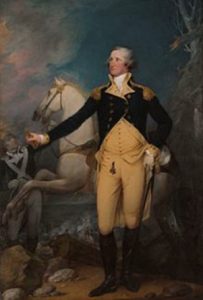The Battle of Princeton
- January 3, 1777
A Pivotal Moment in the American Revolution
The Battle of Princeton on January 3, 1777, was a decisive victory for General George Washington and the Continental Army, marking a turning point in the American Revolution. This battle, fought in the wake of the Ten Crucial Days, proved that the American forces could stand against the British and secure momentum for the fight for independence.
On these very grounds, ordinary men did extraordinary things, rallying under Washington’s leadership to defeat British regulars, raise American morale, and change the course of history. Today, the Princeton Battlefield remains a National Historic Landmark, honoring the bravery and sacrifice of those who fought for freedom.


The Battle of Princeton (January 3, 1777) was a pivotal battle of the Revolutionary War in which General George Washington’s army of Continental soldiers and militia defeated British regular forces.
On the night of January 2, 1777, George Washington’s army repulsed a British attack at the Battle of the Assunpink Creek in Trenton (also known as the Second Battle of Trenton). That night, General Washington evacuated his army of about 5,000 men from its position, circled around the flank of General Lord Cornwallis’ army, and went to attack the British 4th Brigade garrisoned at Princeton and under the command of Lieutenant Colonel Charles Mawhood.
As Washington approached Princeton from the southeast he did not realize that Mawhood had been given orders to reinforce Cornwallis still in Trenton and was leading a column on the Trenton to Princeton Road. From a hill on this road just south of Stony Brook, Mahwood spotted the Continentals approaching the Princeton garrison. He reversed his column, and engaged the center of the American army’s left flank at sunrise on January 3, 1777 one mile south of Princeton on the Quaker farms of William Clarke and his brother, Thomas. At first the British gained the advantage against General Hugh Mercer’s Virginia brigade, and Washington sent militia units under Brigadier General John Cadwalader in support. The militia, on seeing the flight of Mercer’s men, also began to flee. Washington rode up with reinforcements and rallied the fleeing militia, personally leading a counterattack on Mawhood’s troops that placed him directly in the field of fire. Washington’s counterattack resulted in an organic double envelope maneuver and Mawhood’s 17th Regiment of about 450 men was nearly surrounded. Mawhood gave the order for a general retreat, scattering the British to the north, south and west.
The victorious Washington then approached the town of Princeton where Brigadier General John Sullivan had forced some 200 to 300 British troops who had taken refuge in Nassau Hall to surrender. After the battle, Washington moved his army to Morristown, having won a third victory in just ten days. Humiliated, Cornwallis withdrew his army north to Brunswick, Staten Island and New York. With the victory at Princeton, morale rose dramatically among the Americans. More citizens rallied to the cause of liberty and the British would never again occupy the “Jersies.” Today, this battle is honored on the hallowed grounds that are Princeton Battlefield State Park, a National Historic Landmark.
A Timeline of the Battle of Princeton
The thirteen American colonies declare their independence from the United Kingdom and become the United States of America. New Jersey’s five signers, Princeton’s Richard Stockton and Rev. John Witherspoon, Hopewell’s John Hart, Bordentown’s Francis Hopkinson, and Elizabeth’s Abraham Clark sign for New Jersey.
The American Army is defeated at the Battle of Long Island and begins a series of retreats across Manhattan, Westchester, and New Jersey.
The tattered remnants of the American army crosses the Delaware River into Pennsylvania, pursued by the Crown forces. Indpendence is thought to be a lost cause.
Thomas Paine’s American Crisis is published in Philadelphia. His soaring words, “These are the times that try men’s souls,” help lift sagging American morale.
George Washington leads a daring nighttime crossing of the icy Delaware River from Pennsylvania to niine miles north of Trenton. The men cross in a howling snowstorm, beginning a bold campaign to revive the American cause after months of defeat.
During the early hours of December 26, two columns of American soldiers march through the snow to Trenton. One follows a river route and the other follows the Pennington Road. Washington’s army surprises and defeats the Hessian troops in Trenton, sending shockwaves through the British army and Loyalists, electrifying the colonies, and starting 10 days that will turn the tide of the war and change history.
Smarting from their defeat in Trenton on December 26, the British march on Trenton from Princeton, but thanks to a brilliant delaying action by Washington and muddy roads hard to march on, the British don’t arrive until dusk. Despite three British attacks, the Americans hold the line.
Over the course of the evening, temperatures drop, freezing the ooze and mud that had slowed the British.
January 2, 1777, 10 PM
Washington instructs the soldiers to conduct an elaborate ruse to persuade the British that the Americans are fortifying their position. Troops are told to stoke bonfires and make it sound like they are digging trenches. Between 10 PM and midnight, Washington sends his baggage wagons to Bordentown and starts his men marching east around the British lines.
Taking advantage of now frozen roads, the troops turn north and approach Princeton along the Quaker Road.
By approximately 7:45 AM, the Ameicans are assembled on Quaker Road, preparing to complete the march on Princeton. The temperature is 20 degrees and the sky is clear.
Troops assemble along Stony Creek, near the Quaker Meeting. One division continues to march north, crossing the King’s Highway, and loops north through the woods to ward Princeton. A second group turns east, marches behind the Thomas Clarke House on the Trace Road toward the southern approaches to Princeton. A third division follows.
As the second and third divisions march east on the Trace Road, they see sunlight reflecting to the northwest on Conhrane’s Hill. The reflections comes from British bayonets carried by British units marching west on the King’s Highway, to reinforce the British in Trenton.
The British discover the Americans at roughly the same time. Lt./ Col. Mawhood makes the fateful decision to engage the Americans and send troops southeast, toward the William Clarke House. William and Thomas Clarke are brothers, Quakers, whose houses face each other on a diagonal across their farm fields.
Virginia, Delaware, and Maryland troops under General Hugh Mercer cross Thomas Clarkes fields to William Clarke’s orchards to engage the British. After momentary American success, the British ocunterattack, Mercer is mortally wounded, and his troops begin to falte. The British drive Mercer’s troops back across the field to the ridge on which Thomas Clarke’s house sits.
Cadwalader’s Philadelphia Associators rush to reinforce the Americans and they are driven back, but Thonmas Moulder’s battery, sitting to the right of the Clarke house hold off the British troops.
Washington, recognizing defeat is imminent, gallops to the front of the American lines, within musket shot of the British muskets, and rallies the American soldiers. New England troops from the first division of Americans attack from the British left, Cadwalader’s men rally and return to the field, and Mifflin’s Pennsylvanians, marching alongside Stoney Creek, climb the ravine to the battlefield and attack from the British right. The British break and flee, some toward Trenton and others back toward Princeton.
The first division of Americans, under General John Sullivan, continues to march up the Trace Road toward the backdoor to Princeton, its southern outskirts. At a ravine that is now within the confines of Springdale Golf Course, British troops attempt a stand, but break when the Americans fire cannon at them. The British retreat to the College of New Jersey's Nassau Hall in town or flee further north to New Brunswick.
The American army converges on the remaining British soldiers, holed up in Nassau Hall. American Artillery fire on the building, and according to legend, hit a painting of King George II, decapitating him. The cannon are fired by a young officer, Alexander Hamilton.
The British surrender and the Americans begin to collect the British supplies stored in Princeton. Washington wants to push on to New Brunswick and capture the British war chest, but is persuaded the men are exhausted and weakened by two days of non-stop fighting and marching without sleep or food.
The British army in Trenton, marches north after hearing the cannonade from the battle. The troops, under Lord John Cornwallis, approach the bridge over Stony Brook and the Kings Highway and are fired on by the rearguard of the American Army, which has torn the planks off the bridge.
Hearing this, Washington’s troops begin marching north across the Millstone River, en route to winter quarters in Morristown.
Before the Crossing, even Washington was despairing of the American cause. Congress had fled to Baltimore, from Philadelphia, certain that the British and Hessians would occupy the capital city. New Jerseyans were taking General Howe’s loyalty oath in droves, forsaking the cause. The British believed their armies were invincible against the ragged Americans.
The two Battles of Trenton and the Battle of Princeton changed all of this. Washington’s wily and surprising wins punctured British assumptions about their power and forced their officers to reassess Washington and the Americans. Americans did the same and the War for Independence, which had been a flickering candle on the night of December 25th, began to burn brightly again.
The British retreated from most of New Jersey and the New Jerseyans renounced their loyalty oaths given only months before. The Americans would live to fight another day.
The Battle of Saratoga in the fall of 1777 is called by some the “turning point” of the Revolution, but without Princeton, there is no Saratoga, no French alliance, and no eventual victory at Yorktown.
The Road to Independence ran through Princeton on January 3, 1777.
